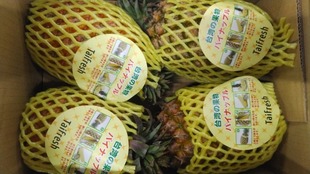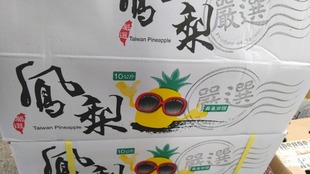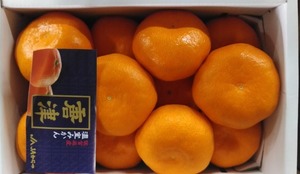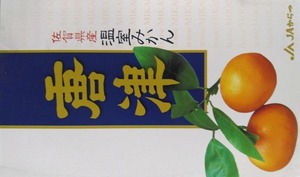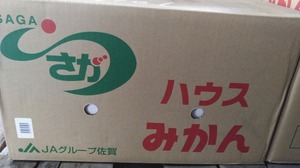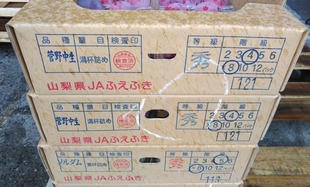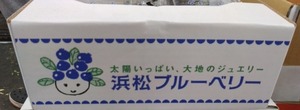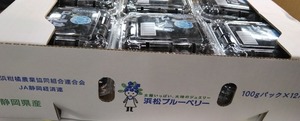Winter local cuisine of Nagai City, Yamagata Prefecture! “Turnip soup”. Miso soup with turnips, Uchimame beans, and fried tofu. Soybeans are placed on a stone mill, crushed with a mallet, and dried. So nutritious that it's called "meat from the field"
【Product name】
Secret roasted soybeans(馬のかめしめ等)
【Class】
Glycine max L. Merrill
【Producing area】
Nagai City, Yamagata Prefecture (JA Yamagata Okitama Nagai Green Soybean Association)
【Origin of name】
From hitting and crushing one soybean with a wooden mallet. Umanokamishime, a native variety of edamame in Yamagata along with Dadachamame, is made in the southern part of Yamagata Prefecture, especially in Nagai City. When it comes to soybeans, it seems that the soybeans came to be called soybeans because the surface of the soybeans has marks that look like they were bitten by a horse.
【Major features】
Roasted soybeans are mashed and dried soybeans. It is a preserved food that has been handed down in Fukui, Niigata, and Yamagata prefectures, which have a lot of snow on the Sea of Japan side, and has been eaten since ancient times as a valuable source of nutrition during the winter. I still vividly remember how my grandfather and grandmother served me many times when I was a child. Since it is crushed, it absorbs water quickly, and it seems that there is no need to soak it in water overnight like dried beans. Also, since it is crushed, the heating time is short, overturning the stereotype that it takes time. In addition, it has a wide range of culinary uses, such as simmering it with other ingredients or adding it to a salad after being boiled for about 10 minutes. Locally, it is added to miso soup, simmered dishes such as hijiki seaweed, pickled dishes such as the dish of raw fish and vegetables seasoned in vinegar, and boiled rice with fish and vegetables mixed in advance. Uma-no-kameshime soybeans are said to have been given this name because they have marks on the surface that look like they were chewed by a horse. stopped. Since some farmers in Nagai City had kept the seeds, they revived cultivation in 2006 and increased the amount of cultivation. Currently, several farmers of the "Umanokamishime Producers Association" are planting 2.5 hectares and harvesting 3 tons of soybeans a year. This excellent agricultural product grows vigorously, can reach a height of 1 m, and has a large number of pods and a high yield. and short term. The more you bite into it, the more it tastes richer, and the more chewy it becomes. It is used in processed products such as miso, natto, and tofu. In 2009, a confectionery craftsman in Nagai City developed an original sweet and became a specialty product. Nagai City Regional Crafts: Around 1972, they started making wooden toys such as pieces and daruma dolls. Then, in 1975, when the Japan Cup and Ball Association was established, they started making competitive cup and ball (certified by the Japan Kendama Association). Competition cup and ball, unlike folk crafts, have few decorations and have strict standards that do not allow even 1 mm of error. Nagai's cup and ball. Sericulture has been practiced since the early Edo period, and mainly raw silk and other raw materials were exported. It started with the production of cotton crepe cloth under Yozan Uesugi's industrial promotion policy. The warp was made of raw silk, and the weft was made of silk spun from floss. From the end of the Edo period to the Showa period, Nagai Tsumugi was produced mainly in Nagai Tsumugi in the Okitama region. In the middle of the Meiji era, Nagai Tsumugi became known nationwide, and in 1976, it was recognized as a "traditional craft" designated by the Minister of International Trade and Industry as "Okitama Tsumugi" including Nagai Tsumugi. Pottery Narushima ware Wakui kiln: About 240 years ago, Yozan Uesugi, the founder of the revitalization of the Yonezawa clan, had his vassal Seizaemon Sagara learn Soma ware and build a kiln in Narushima, Yonezawa city, as part of his policy to promote new industries in order to support the clan's finances. No gorgeous painting is used, and the work is finished only with sea urchin glaze, black glaze, and kiln transformation caused by firing in the kiln. It is said that this reflects the Uesugi clan's ethos, which emphasized simplicity and robustness. It played a major role in stabilizing the economy of the clan and continued to be fired until the middle of the Meiji era. A kiln was built in Narushima, Yonezawa City. Gorgeous painting is not used, sea rat glaze, black glaze and kiln firing. It is special to finish the work only by the kiln transformation caused by signs. This is the ethos of the Uesugi clan, who valued simplicity and robustness. Is said to reflect Economic stability of the domain. Narushima ware, which played a major role in After that, it was placed on the crockery. It becomes an abandoned kiln due to various circumstances such as The founder of Wakui Kiln, Fujio Wakui, started Nagai ware at Imaizumi in 1965, but many influential people and intellectuals in Yonezawa requested and cooperated in the revival and restoration of Narushima ware in the Yonezawa clan. After 10 years of research activities for reconstruction, Narushima ware was revived. I also visited when I was a child, but I am also distantly related to my mother's side, and now I cannot find the opportunity to go, but I would like to see when the time is right. In January 2010, it was designated as a designated art by Nagai City. Lion head carving: The lion head is mainly made of willow wood. It is roughly carved from a log and dried in the shade for about half a year. After carving it for about a month and drying it again, it is finished with painting. The production period is about 3 years, and it is handed over to the shrine for the black lion dance. Approximately one more year of curing is required before it can be used. Essential Each shrine has different eyes and eyebrows, and it's fun to see the characteristics of their faces. The black lion head is used for lion dance and for decoration, and is also displayed in ordinary households as a symbol of exorcism. Kanaigami broom began in the late Edo period, when peddlers traveling from Yonezawa to Aterazawa told the people of the Kanaigami district about the techniques and seeds of making morokoshi brooms. It is said that it can be used for 3 years in the tatami room, 3 years in the entrance, and 3 years in the outside. It is still used by many people today. In Nagai City, the soil is prepared using the separated organic waste Rainbow Plan compost, and agricultural products cultivated with reduced chemical pesticides and fertilizers are labeled with the Rainbow Plan agricultural product certification mark. Safe and secure agricultural products supported by citizens are displayed in stores while they are still fresh. Reliable food starts with soil preparation, and we are working on a recycling-oriented town development "Rainbow Plan" that mediates organic resources in the area. Garbage carefully sorted by households in urban areas is transformed into high-quality compost at the composting center as a valuable resource, which is used to prepare the soil for farmland in the city. Agricultural products grown on composted farmland are delivered to local supermarkets and direct sales outlets, where they are lined up on the dining tables of citizens. Garbage is reused as a resource, building a cycle of food and agriculture. In addition, Rainbow Plan agricultural products are used in school lunches in the city, and are also used to make special products, such as Rainbow Ramen and Rainbow Vegetable Sweets, which are popular. In addition, it seems that many people from Japan and abroad are visiting Nagai City because of the Rainbow Plan. The circle of circulation that connects food and agriculture, people and people, and the present and the future is expanding. The seed coat on the surface is a slightly wide shade of light green to yellow. When the skin is peeled off, the inside is also green. It is a very sweet soybean with a very good taste. The amount of cultivated soybeans is still small and it is very popular as a very rare and delicious soybean. Yonezawa City, Located at the southernmost tip of Yamagata prefecture. It is located in the Yonezawa basin at the foot of the Azuma mountain range, which is the source of the mother river “Mogami River”, and borders Fukushima Prefecture. It is the fourth of the 35 municipalities in the prefecture and boasts an area of 548.74 km2. The highest point is the west Azuma mountain range at an altitude of 2,035 m, and the highest point in the city is 260 m above sea level, which is low from south to north. The summer is hot and humid, the annual rainfall is a little lower than the national average, and the winter is a harsh environment. It is designated as a special heavy snowfall area designated by the prefecture, and the cumulative annual snow depth can reach 10 m. Even in the city, there is enough snowfall to reach the maximum snow depth of about 100 cm in normal years, and I miss the countryside. Including Shirabu hot spring, Ubayu hot spring, Ohira hot spring, Nemekawa hot spring, Shintakayu hot spring, Goshiki hot spring, Yunosawa hot spring, etc.(“Oushusantakayu”: Zao, Shirabu, Takayu)There are abundant hot springs, and you can easily enjoy mountain climbing and skiing in the summer mountains. “Maeda Keiji Dochu Nikki(Diary)” (Yonezawa city designated cultural property, owned by Yonezawa Library). Due to the influence of the manga 'Hana no Keiji' featuring him, he is quite often called Keiji MAEDA. It is said that he was from the Takigawa clan (ninja family), but he was adopted by Arako castle owner, Toshihisa Maeda. Kabuki-mono: Especially in the European and American block, the culture of 'Japan' as imagined by foreign people was likely to be exaggerated in some part or being mixed with China and being stereotyped, due to curiosity (exoticism) about a culture of which the ancestry was completely different from that of Christian culture, and many 'perception biases' from the Japanese viewpoint were seen (even now, there are many foreign travelers who are surprised to know that Japan has no 'ninja' (professional spy in feudal Japan highly trained in stealth and secrecy)). After the Western Army lost the battle and the territory of the Uesugi Clan was reduced to 300,000 koku of rice and relocated to the Domain of Yonezawa, Mr. Toshimasu served the Domain of Yonezawa and retired to Domori near Yonezawa (currently known as Keijisimizu in Domori, Bansei-Town, Yonezawa-City). Nanyo City, It is located in the Okitama basin in the south, surrounded by the Azuma and Iide mountains from the south to the west, with the Ou Mountains in the east. The northern part is a mountainous area with an open field in the south, and the climate is blessed, making it suitable for growing rice, vegetables, and fruit trees. Is your aunt doing well? Contact me once in a while. July: Chigomai at the Kumano-jinja Shrine (Nanyo City) (the Kumano-jinja Shrine in Nanyo City). It is said that animals, plants, and human beings are born in this world by the power of “Musuhi(A spiritual work that creates, develops, and completes heaven and earth and all things with the idea of Shinto.)”. Nagai City(100 beautiful Japanese uneven landscapes; plains), Born in November 1954 by the merger of five villages in one town. Located in the southwestern part, the place name is derived from “a place where water gathers”, and countless streams run in the mountains. The town is blessed with water resources where the nogawa river, shirakawa river and mogami river flow, and the construction of a multipurpose dam “Magai dam” with functions such as flood control is being promoted. In addition, it is a flower town where flowers such as “Kubo Zakura(Isazawa: Cerasus itosakura (Sieb.) Masam. & Suzuki f. ascendens (Makino) H. Ohba & H. Ikeda)”, “Tsutsuji(Rhododendron L., azalea)”, “Ayame(Iris sanguinea Hornem., 1813)”, and “Hagi(Bush clover, Japanese clover)”, which are nationally designated natural monuments(“Two-stage designation of monuments,” is a system in which, in respect of historic sites, places of scenic beauty and natural monuments defined as “monuments” by the Act on Protection of Cultural Properties, monuments selected as 'especially important' among those designated by the national government are classified into the categories prefixed with 'Special' to call them “Special Historic Site,” “Special Place of Scenic Beauty” or “Special Natural Monument,” respectively.)that bloom in rich soil, color the four seasons. About 300 years ago, it prospered as a commercial city by the Mogami River transport of the Uesugi Yonezawa clan. Nagai's culture and industry have blossomed greatly, supported by the rich wealth of the large merchants that have been accumulated. Waterways still run like a net in the city, and they are used as water for daily life, but I miss them when I remember the past. Utilizing the waterway, a regulated waterway will be provided and supplied to small and medium-sized rivers as water for snow removal, which will be used for snow removal during the winter. Underground water from the clear stream Okitamanogawa River was taken and supplied as drinking water, and was healed many times as a child. Autumn tradition “Imonikai; Imoni is soup with meat and various type of vegetables which are harvested in fall. Imoni party lile BBQ we enjoy cooking Imoni soup outside is famous events in Fukushima and Yamagata prefecture”: Along the Mogami River embankment. There are many legends and customs related to water. Kurojishi Festival: It is a traditional Shinto ritual that has been handed down to various shrines in Nagai City, which dates back 1000 years, and is currently inherited by more than 40 shrines in the city. Water drunk before an altar to symbolize the making of a vow: Mizuha. “Nagasuke Terashima, the eldest son of Kagesuke Yoshie, is the bloodline of my ancestors.” In Bodaiji(temple with one's family grave), precious souls, including grandmather, are sleeping. Shingon-shu Buzan-ha Hensho temple(Gyoki Bosatsu). Takahata Town, Higashiokitama District, In the beautiful and fertile town of the alluvial fan of the Yashiro River and Wada River, which have their headwaters deep in the mountains of Ou. MAHOROBA(Easy to live in, wonderful, Historical and cultural heritage from the ancient Jomon period.): Derived from the ancient word “mahora” often found in Kojiki, it means "a fertile and comfortable place to live surrounded by mountains and hills. Golden rice ears sway on the fertile flat land, and fresh grapes, apples and pears grow in the mountains. I connected my hands and went to the farm, and even though I couldn't do it, I said that I would help, and I took care of it. Due to the peculiarity of the basin, the season is clear, the summer is hot, and the winter tends to be extremely cold. Especially in the winter, a large amount of snow falls due to the seasonal wind from the continent. The large temperature difference between day and night has a positive effect on the growth of agricultural products. That's why it's delicious. Takahata Castle (Takahata Town, Higashi-Okitama County, Yamagata Prefecture): It is also called Kanega Castle because its shape resembles a bell. It is said that there was Honmaru in the current Takahata school ground and Otemon near Showa nursery school. Suehira Hizume built the castle. “Kawanishi Town”, Located in the Okitama region in the southern part of Yamagata prefecture. Birth merged with one town five village in 1955. That's Komatsu Town, Otsuka, Inukawa, Chugun, Tamaniwa, Yoshijima Village. Since it is located on the west side of the Mogami River, it was named by Kawanishi Town and its pioneers. During his stay in Komatsu, Isabella Lucy Bird praised the Yonezawa Plain as the Garden of Eden and the Arcadia of Asia. This is probably because the terrain is roughly divided into vast countryside and gentle hills, and is blessed with abundant nature. Japan's largest scale “kawanishi dahlira garden” is a 4 hectare garden with 650 species and 100,000 dahlia x hortensis guillaumin dahlia x pinnata cav(Native to Mexico). Utilizing the abundant nature, it is known as the “rice center” next to the Shonai plain in the prefecture. It has a history and local sake produced from good quality rice and clean water. The deliciousness of Yonezawa beef supported by advanced technology is highly evaluated all over the country. The nationally designated historic site “Shimokomatsu tumulus group(From the north, it is divided into six branches of Jingamine, Eishoji, Yakushisawa, Takamachiba, Komoriyama, and Amagasawa, and the total number of tumulus is 202.)” and the prefecture-designated historic site “Tenjinmori tumulus(1984 『川西町埋蔵文化財調査報告書6:天神森古墳発掘調査報告書』川西町教育委員会社会教育課)”, which is the largest front and rear tumulus in Tohoku. Protection of Japanese serow(Capricornis crispus (Temminck, 1844): 日本書紀, 643年頃(皇極天皇2年),「岩上に, 小猿米焼く, 米だにも, たげてとおらせ, 山羊(カマシシ)の老翁」), a special natural monument. Shirataka Town, Nishiokitama District, Located in the southern center of the prefecture. The eastern part is the Shirataka hills, the western part is the Mt. Asahi system, and the Mogami River flows through the center, blessed with abundant nature. Merger of towns and villages(The town system came into effect on October 1,1954.): Arato, Ayukai, Higashine, Shirataka, Juo,Koguwa. In October of the following year, a part of Nishimurayama District Asahi Town was incorporated. It is widely known as the "classical cherry blossom village" because there are many old trees of Edohigan tree(Prunus pendula Maxim. var. ascendens Makino; Cerasus spachiana Lav. ex Otto f. ascendens (Makino) H. Ohba)that are over 500 years old. Along the Mogami River: The rich countryside spreads, and raw milk is produced mainly by rice cultivation, apples, tomatoes, and dairy farming. It is also famous as one of the leading production areas of Akebia introduced earlier. Atago-yama (Shirataka Town): Altitude 348 m. “Iide Town”, It's located in the southwest, but I'd love to visit it once. To the east are Yonezawa City and Kawanishi Town. Adjacent to Oguni Town in the west, Kitakata City in Fukushima Prefecture in the south, and Nagai City in the north. The northeastern part is known nationwide for producing good quality rice in agricultural areas using Shirakawa natural water and fertile cultivated land. The hills are beef cattle producing areas, and the southern part is covered with mountains connected to the Iide mountain range. In the town, the large white “lilium auratum” and the pretty pink “Lilium rubellum” bloom typically. An example of the most beautiful village in France: Joined the NPO “The Most Beautiful Villages in Japan” in H20 years. Every day, I am engaged in activities to protect the landscape, environment and culture of Japanese agricultural and mountain villages that cannot be regained. Satoyama landscape scenery and satoyama culture(peri-urban woodland culture)in the Nakatsugawa area, Iide mountain range, Rural scattered settlement. Three local resources were recognized, and it was a great achievement. Hagyu Castle was built by masanobu kokubu and was defeated in 1591 (Tensho 19) and abandoned. “Oguni Town”, Located at the southwestern tip, on the prefectural border with Niigata prefecture(The second largest municipality among the 35 municipalities in Prefecture.). The town is surrounded by magnificent mountains such as the Asahi mountain range and the Iide mountain range, which belong to the bandai asahi national park. Deciduous broad-leaved forests spread out to cover the entire town, including the beech forest that leaves a primitive landscape, soothing us. Due to the influence of the climate on the Sea of Japan side, it rains a lot in summer, and in winter it is one of the most heavy snowfall areas in Japan. It is said that the amount of snow does not fall below 2 m even in the center of the town, and in some mountain villages it reaches up to 5 m. It is one of the most heavy snowfall areas in Japan, and the heavy snowfall of 1963 turned the town into an “isolated island on land.” However, a lot of rain and snow store abundant water(The corporation that paid attention to the feat of constructing a hydroelectric power plant and using the electric power to start manufacturing alloy iron such as ferrosilicon in 1938.)in the land and nurture the lives of many animals and plants that inhabit it, including forests. It has become a very important water resource, and outdoor sports and events are actively held, promoting the revitalization of each region. We are trying to promote it by utilizing the vast land, rich natural environment, and unique living culture that is deeply related to nature as “town advantage”. People have a mountain respect hold dear heart in the form of faith in god. It is a subject to be afraid of because of its divine appearance and the rigor of being violent in a disaster. A great being who is an object of fear and at the same time gives water and food to live. As many as 80 mountain gods are scattered so as to cover the villages of the town, which tells the story of the people's faith duration of breeder's rights of 3 years.「山形おきたま伝統野菜: 山形おきたま伝統野菜振興協議会」, おかひじき(Salsola komarovii Iljin(Modest Mikhailovich Ilyin(波, 旧ソ連), Saltwort), うこぎ(Araliaceae Juss(Antoine Laurent de Jussieu(仏). ), 小野川豆もやし(「三沢村大字小野川もやし業組合(現: 米沢市南西部)」1923年, 06/01), 雪菜(Brassica Campestris L. var. Chinensis L.(米沢市, 斜平山麓)), 薄皮丸なす(南陽市,「沖田与太郎」氏が, 1945年代, 新潟からの行商人を通じ, 種子を入手し, 選抜 ≒ 沖田なす), 花作だいこん(山形県長井市花作(はなつくり)地区, Pickles that can be stored for a long time and are one-third the length of normal), 高豆蒄瓜(東置賜郡川西町高豆蒄(こうずく), 果実が成熟しても糖を蓄積せず, 甘くならないメロン類の変種: Cucumis melo L. var. utilissimus (Roxb.) Duthie et Fuller 'Albus'), 紅大豆(赤豆: Vigna angularis: 東置賜郡川西町), 畔藤きゅうり(西置賜郡白鷹町畔藤(くろふじ)地区: It is 30-35 cm long, 3.5 cm in diameter, and weighs around 250 grams, and is characterized by its elongated black warts), 宇津沢かぼちゃ(西置賜郡飯豊町中津川地区宇津沢: 八郎かぼちゃ: The color of the peel is orange, and the flesh is bright yellow), 梓山大根(米沢市万世町梓山(あずさやま)地区: ずさやま: It is slender and tapered, with red streaks on the surface, and leaves with sardines not found in other radishes. The meat is hard and spicy), 小野川あさつき(Allium schoenoprasum L. var. foliosum Regel(Eduard August von Regel(独)): 米沢市小野川地区: It has less spiciness and is crunchy, and has been sold since the 1945s, just like bean sprouts), 夏刈ふき(Petasites japonicus (Siebold(Karl(Carl)Theodor Ernst von Siebold(独)) et Zucc(Joseph Gerhard (von) Zuccarini(独)).) Maxim(Karl Johann Maximowicz(露)). 東置賜郡高畠町夏刈地区: 喘妙蕗:東置賜郡川西町), おかめささぎ(Phaseolus lunatus L(Carl von Linné(瑞)). ライ豆), 窪田なす(米沢市窪田地区: 直江(樋口)兼続), 遠山かぶ(米沢市上長井(遠山)地区: 山形おきたま雪菜生産部会: Brassica campestris), 馬のかみしめ(長井市: 青平豆: The more you chew,the more the flavor comes out), 八ツ房なす(長井市: 矢久保家, It has survived by protecting the seeds for generations(伝統野菜として, 平成28年1月認定). Traditional vegetables are vegetables of native varieties that have been cultivated in various places since the ancient times. ), つくも高菜(東置賜郡高畠町津久茂(九十九, 筑茂, 津久茂)地区: Can be cultivated without using pesticides: The leaves and stems are soft and pungent and have a beautiful green color)Traditional vegetables recommended by cities and towns in the Okitama area. A native species that has been cultivated since before 1945 and conveys the history and food culture of the Okitama region. Currently, 18 items are certified. A way of living that has accumulated various ingenuity and efforts in the preservation and use of ingredients in order to survive a long winter. We have a long and cold winter, but we know how to enjoy it.「いいねぇおきたま」登録番号, 第4029853号, 登録日, 平成9 (1997) 年7月18日, 登録公報発行日, 平成9 (1997) 年10月2日, 出願番号, 商願平07-65914, 出願日, 平成7 (1995) 年6月30日, 先願権発生日, 平成7 (1995) 年, 6月30日, 更新申請日, 平成29 (2017) 年1月23日, 更新登録日, 平成29 (2017) 年1月31日, 存続期間満了日, 令和9 (2027) 年7月18日, 第4427924号) 登録日, 平成12 (2000) 年10月27日, 登録公報発行日, 平成12(2000)年11月28日, 出願番号, 商願平11-116729, 出願日, 平成11 (1999) 年12月21日, 先願権発生日, 平成11 (1999) 年12月21日,更新申請日, 令和2 (2020) 年6月24日, 更新登録日, 令和2 (2020) 年6月26日, 存続期間満了日, 令和12 (2030) 年10月27日, 商標 (検索用), いいねぇおきたま, 称呼, イイネエオキタマ, イイネーオキタマ, オキタマ, 権利者, 氏名又は名称, 山形おきたま農業協同組合, 東置賜郡川西町(J-Plat Pat). “Secret beans” have long been eaten with soybeans as a preserved food, and have not been widely available as raw edamame; green soybeans. The seed coat on the surface has a slightly wide range of colors from light green to yellow, and when the skin is peeled off, the contents are also green. This secret bean is a very sweet soybean with a very good taste. I hear that it has spread mainly in this region because of its deliciousness. OKUTE-soy beans: Evening drink Boiled Brown Edamame and Yukine(Ministry of Agriculture, Forestry and Fisheries variety registration, Application No. 19209 Date of application 2006/01/10 Date of publication of application 2006/10/23. Glycine max (L.) Merr. No hypocotyl anthocyanin coloring, finite growth type, white hair mushroom color, more hair mushrooms, fairly short main stem length, sharp cotyledon shape, white flower color, ripe. The color of the pod is medium, the size of the grain (general group) is large, the shape of the grain is spherical, the ground color of the seed coat is yellow, the color of the umbilical cord is yellow, the flowering period is medium, the maturity period is early, and the branch The number is medium, the number of main stem nodes is small, the height of the lowest pod node is medium, the number of leaflets is three, the difficulty of splitting is medium, the seed coat is monochromatic or multicolored, and the cotyledon color of the grain. Is yellow, and the ecological type is intermediate. The application variety “Yukine beans” has a larger grain size (general group) than the control variety “Sayanishiki beans”, and the background color of the seed coat is yellow. It is said that the distinction is recognized by the fact that the flowering period is in the middle. Registration number 18018 Date of registration 2009/03/19 The duration of breeder's rights is 25 years. Name of cultivar registrant, Snow Brand Seed Co., Ltd., Atsubetsu Ward, Sapporo City, Hokkaido, Registered cultivar breeder, Mr. Omi, Mr. Honda, Mr. Ohashi. Secret Beans is Iwate Co., Ltd. Masayuki Sato Seedlings (Head office location: Minami, Ryutsu Center, Shiba District, Iwate Prefecture, founded in 1908, incorporated in 1966, business content Research and development and production of seeds and seedlings, wholesale of seeds and seedlings, Retail, processing and sales of agricultural vinyl and poly, sales of agricultural production equipment and materials, design and construction of facility gardening, construction of large steel frame houses, design and construction of fruit shelves and columns, sales of fertilizers and pesticides, Agricultural Problems Study Group Secretariat, German Iris Festival Holding Secretariat, Agricultural Waste (Waste Plastic) Collection and Transportation Business, Sales Offices, etc .: Hizume Sales Office, Mizusawa Sales Office, Yamada Branch Office, Agricultural Bi-Processing Center, Breeding Institute) Born. Started selling in 1988. It seems that it was developed with the aim of making large pod beans that are resistant to diseases and have a flavor.

A traditional preserved soybean food from the Okitama region of Yamagata Prefecture. Aobata beans (green soybeans) can be crushed and cooked easily without rehydration. It seems to go well with simmered dishes and miso soup. Beans are simply soaked in water, dried, and flattened. However, since the beans are mashed as they are, it is rich in nutrients such as high-quality vegetable protein, isoflavones, and dietary fiber, making it an ideal ingredient for health-conscious people. Even though the beans are hard to cook and flattened, they cook quickly and are very easy to handle. In addition, since it is a dry food, it is an excellent product that can be stored at room temperature for a long time.

Compared to yellow soybeans, green soybeans contain less oil and, in exchange, have a slightly higher sugar content. In addition, compared to ordinary beans, it looks larger and stimulates the appetite. Richly flavored, sweet, low-fat and rich in flavor, this hidden gem has a high rarity value.

The texture and taste of secret beans were so delicious that they spread mainly in the Tohoku region. In 2008, Masayuki Sato Seeds (Oshu City, Iwate Prefecture) acquired the trademarks of "secret beans" and "secret green soybeans." It retains the characteristics of the original parent edamame, and is reborn as a soybean that retains the taste and texture of edamame even when matured. Also, it is not genetically modified.



